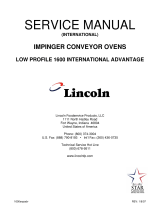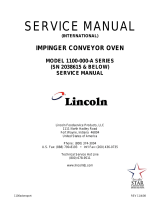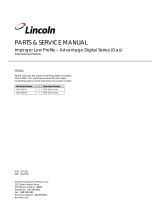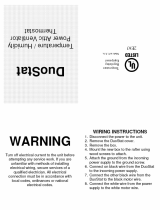
Low Profile -–1600 Series Service Manual – Dom & Int’l 7
SEQUENCE OF OPERATIONS / 1646, 1647, 1650, 1651
MODEL 1646 / 220-240 VAC / 50 HZ / NATURAL GAS
MODEL 1647 / 220-240 VAC / 50 HZ / L.P. GAS
MODEL 1650 / 220-240 VAC / 50 HZ / TOWN GAS
MODEL 1651 / 220-240 VAC / 50 HZ / TOWN GAS
POWER SUPPLY Electrical power to be supplied to the oven by a three conductor service.
Brown conductor is hot.
Blue conductor is neutral.
Green conductor is ground.
CONTROL BOX AUTO COOL AUTO
COOL DOWN
When the temperature in either one of the Control Boxes reaches 120°F ± 3°F (49°C
± 1.7°C), the Cooling Fan Thermostats will switch power to the Cooling Fans. The
thermostats will interrupt power to the Cooling Fans when the temperature falls to
100°F ± 3°F (37°C ± 1.7°C).
MAIN FAN CIRCUIT Line voltage is permanently supplied to a normally open contact of the oven power
switch, through a 10A fuse to the normally open oven fan relay, and through a 3A
fuse to the primary of the control circuit step down transformer (The transformer steps
the voltage down to 120 VAC for the control circuit). 120 VAC is permanently supplied
to the (2) normally open cooling fan thermostats, a normally open contact of the cool
down relay, terminal #1 of the 20 -minute time delay module and to the normally open
oven power switch. Closing the oven power switch supplies 120 VAC to the cool-
down relay, its contacts now close, supplying 120 VAC to the (2) cooling fans. and
enabling the 20 minute time delay module. The 20-minute time delay module supplies
120 VAC to the oven fan relay, its contact now closes supplying line voltage to the (2)
main fan motors. 120 VAC is also supplied to the (2) time/temp transformers, the
conveyor switch and the (2) electronic temperature controls.
BURNER CIRCUIT NOTE: This oven utilizes (2) complete Burner/Temp. Control Systems. The sequence
of operations is the same for each system. Closing the normally open oven power
switch supplies line voltage through a 3A fuse, through the sail switch, through the
gas pressure switch, through the Main Fan Air Pressure Switch, through the Hi-limit
Thermostat, to the Ignition Control. The combustion motor is energized. The normally
open combustion air switch closes upon sensing air pressure. After a pre-purge
period of between 30 and 60 seconds, the Ignition Transformer and the Main Gas
Valve are energized. Ignition should now occur.
NOTE: The Cooling Fan Sail Switch is mounted in front of the cooling fan and is
activated by the air flow of the Cooling Fan.
TEMPERATURE
CONTROL
Closing the Oven Power Switch supplies 120 VAC (through the Step Down
Transformer) to the Temperature Control Board. The 2.5k ohm Temperature Pot is
adjusted to desired temperature. The Thermocouple will provide varying millivolts to
the Temperature Controller. The Temperature Controller supplies 120 VAC to the
Solenoid Valve at intermittent intervals to maintain desired temperature.
CONVEYOR DRIVE Closing the Oven Power Switch supplies 120 VAC, through the contact of the Oven
Power Relay, to the normally open Conveyor Switch. Closing the Conveyor Switch
supplies 120 VAC, through a 3 Amp Fuse, to the primary of the Conveyor Control
Transformer. The secondary of this Transformer supplies 10 VAC and 29 VAC to the
Conveyor Control. The conveyor control supplies voltage pulses to the Conveyor
Motor. The Conveyor Control Potentiometer varies the frequency of these pulses. The
motor speed will increase or decrease, as the frequency of the pulses increase or
decrease respectively.
TIME/TEMP DISPLAY Closing the Oven Power Switch supplies 120 VAC, through the contact of the Oven
Power Relay, to the primary of the (2)Time/Temp. Transformers. The secondary
output of the Transformers, 12.5 to 15 VAC with a center tap, is supplied to terminals
1, 2, and 3 of the Time/Temp. Display. The Display works on a balanced input, and
center tap voltage to each leg must be 1/2 the total reading. The speed side of the
Time/Temp. Display is supplied, by the Conveyor Control, with the frequency of the
pulses to the Conveyor Motor. These pulses are converted by the Time/Temp.
Display into a read out of minutes and seconds.
NOTE:
The Conveyor Control uses a sensor and magnet, mounted on the Conveyor Motor,
that senses when the motor is turning. If the motor is not turning, the Time/Temp.
Display will show "--:--" in the window. The temperature portion of the display uses a






























